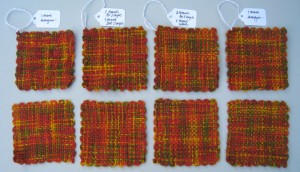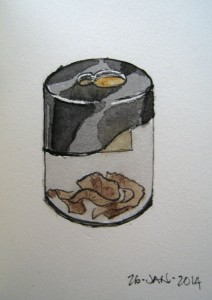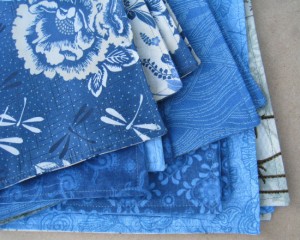During one of the many glasses of wine we consumed during SOAR, I watched Shelia weaving little squares with her Zoom Loom for a Chanel like jacket, using leftover sock/fingering weight yarn. I noticed that she would sometimes double up her yarn before weaving. When asked, she said the fabric was not firm enough when weaving with certain yarns singly.
A light bulb turned on for me. I had been planning a small lap blanket with leftover sock yarn, with squares woven on the Zoom Loom. I had been merrily weaving little square with the sock yarn singly.
After I returned home from SOAR, I pulled out my Zoom Loom and my (very) small pile of woven squares and took another look. Yes, some are really really sleazy. Why I didn’t notice that before is beyond me since I really do know better (see pictures at the bottom).
Next, I pulled out a large ball of leftover sock yarn and wove up 8 squares in 4 different variations. (One of many advantages of having small feet is that I only use less than 2/3 of a skein of sock yarn for a pair of socks.) Here are the squares, all laid out on a board.
Top Row: Straight off the loom (okay, it’s been a few months, but you get the idea)
Bottom Row: Soaked in warm water with Wool Wash, then pressed lightly with a warm iron between towels

(click to enlarge)
Left to Right:
- Single strand for all 4 layers
- 2 strands for first 2 layers, single for the last 2
- 2 strands for the first 3 layers, single for the last 1 (the weaving layer)
- 2 strands for all 4 layers
Unfortunately, you can’t see the density of the fabric very well. I hung these up on my drying rack so you can see the density of the weave.

Before Finishing (click to enlarge)
As you can see, the single strand is very loosely woven. So much so, the threads shifted as soon as the square was removed from the loom, and continued to do so with additional handling.
Using 2 strands for the first 2 layers, and 1 strand for the last 2 was much better, but you can still see a lot of daylight through it.
Using 2 strands throughout was miserable to weave in that last layer. The fabric is very very dense.
But how does it look after wet finishing?

After Finishing (click to enlarge)
Here they are washed and pressed. As you can see, the single strand square is behaving much better.
Depending on what the final product will be, I would likely choose between #2 or #3. In the yarn I chose, I don’t see/feel enough difference between #3 and #4 to warrant the extra frustration of trying to weave in that last layer with 2 strands.
The downside of doubling up the yarn is that the colors are not as clear. This could be mitigated if I chose to pair it with a solid colored yarn as my second strand.
What this exercise tells me is that I should sample sample sample before I commit to a full project. I had been just happy to go along with using 1 strand through out. Now, having seen my options, it would not be the fabric I would choose for a blanket.





 While the sewing machine was out, I decided to sew up some
While the sewing machine was out, I decided to sew up some